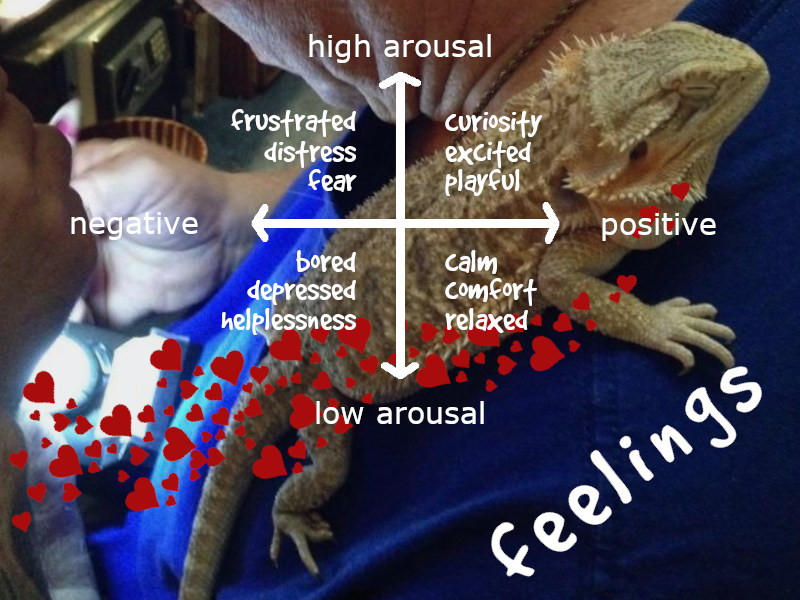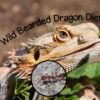Bearded dragons feel emotional states and the physical feelings generated by those emotions. Bearded dragons are sentient beings, much like other pets, capable of feeling a wide range of emotions including pleasure, suffering, and even emotional pain, just as any other animal does.
Like dog and cat owners who recognize their pets’ ability to feel pleasure and pain, it’s important for us to understand that bearded dragons feel these emotions too. We know they are capable of great intelligence and can learn from others. Our connection with these pets is strengthened by their vocalizations, facial expressions, and longer interaction times, facilitated by shared environmental needs.
Contrary to dogs and cats, known for tail-wagging and purring, bearded dragons feel emotions differently due to their unique environmental needs that limit interaction. This difference raises an important question for pet owners: Do bearded dragons feel understandable emotions like joy, sorrow, or affection?
The scientific community largely agrees that all vertebrates experience a form of sentience, which means that bearded dragons feel emotions just as other vertebrates do. However, there’s a notable gap in fully acknowledging and understanding this in reptiles, often leading to misconceptions about their emotional depth. This oversight in recognizing how bearded dragons feel not only influences their treatment in captivity but also impacts their welfare.
It’s crucial for pet owners to realize that bearded dragons feel complex emotions, which often leads to an underestimation of their need for stimulating environments.
Exploring the behavioral and emotional expressions of these creatures, along with dispelling common myths about reptilian emotions, is essential to understanding how bearded dragons feel. This exploration extends beyond the realm of science; it is pivotal in comprehending their interaction with both their environment and human caretakers. Such an understanding is not only academically enriching but also vital for ensuring the humane treatment and overall well-being of these unique creatures. Recognizing that bearded dragons feel complex emotions enhances our ability to provide care that fulfills not just their physical needs but also their emotional health.
Jump To…
Can Bearded Dragons Feel Emotions? A Scientific Overview
Research in herpetology reveals that bearded dragons feel a variety of complex emotions, enriching our understanding of these fascinating creatures. By exploring both their pleasurable and distressing experiences, we gain a fuller understanding of their needs and behaviors. This is particularly important for pet owners who are keen on enhancing the well-being of their bearded dragons by fostering positive states like contentment and happiness.
Research helps us to:
- Understand what makes a bearded dragon happy: Understanding what brings joy and contentment to bearded dragons, such as environmental enrichment and social interaction, is essential.
- Learn to know if your bearded dragon is happy: Learning to identify signs of happiness in bearded dragons, like relaxed body language or active engagement, helps owners create a nurturing environment.
Research in the field of herpetology has gradually peeled back the layers of misunderstanding surrounding reptilian emotions.
In “After 2,500 Studies, It’s Time to Declare Animal Sentience Proven” (LiveScience, Sept 07, 2013), Marc Bekoff, an eminent cognitive ethologist, argues for recognizing animal consciousness. Drawing from his Psychology Today column “Animal Emotions,” Bekoff emphasizes that animals, which includes bearded dragons, feel emotions. He references the Cambridge Declaration on Consciousness, underscoring that non-human animals possess neurological substrates for consciousness, much like humans.
Bekoff’s article, advocating a Universal Declaration on Animal Sentience, highlights that bearded dragons feel pain, joy, and empathy, challenging the view that complex emotions are exclusive to humans. He stresses the need for this understanding in ethical animal treatment and welfare, particularly as society continues to interact with various species.
By asserting that animals, including bearded dragons, feel a range of emotions, Bekoff’s piece is a call to acknowledge and protect animal sentience, rooted in substantial scientific evidence. This declaration aims to foster a more compassionate approach to how we treat and perceive animals.
The Cambridge Declaration on Consciousness, established in 2012 at Cambridge University, marks a significant shift in our understanding of animal consciousness, particularly for reptiles like bearded dragons. This declaration, backed by a group of renowned neuroscientists, concludes that animals including reptiles experience consciousness and emotions, similar to humans.
Key takeaways for reptiles include:
- Shared Consciousness: Reptiles possess the same fundamental brain structures as humans that are responsible for consciousness and emotional experiences. This means bearded dragons feel a range of emotions.
- Emotional Complexity: The declaration acknowledges that reptiles don’t just have basic responses but can experience complex emotional states. This implies that bearded dragons feel emotions that are more nuanced than previously thought.
- Evolutionary Perspective: It suggests that emotional traits seen in humans are also present in reptiles, indicating an evolutionary link. This implies that if humans can feel certain emotions, so can reptiles like bearded dragons.
Overall, the Cambridge Declaration on Consciousness reshapes our perspective on reptiles, recognizing them as sentient beings capable of emotional experiences, which calls for a more empathetic approach towards their treatment and care.
In 2012 at the University of Cambridge a group of well respected neuroscientists gathered to formally recognize sentience in animals. They made a declaration that we humans are not alone in our consciousness, that other beings are just as capable of experiencing affective (emotional) states. The declaration signed by the neuroscientists ended with:
“Consequently, the weight of evidence indicates that humans are not unique in possessing the neurological substrates that generate consciousness. Nonhuman animals, including all mammals and birds, and many other creatures, including octopuses, also possess these neurological substrates.”
Author: Philip Low. Edited by Jaak Panksepp, Diana Reiss, David Edelman, Bruno Van Swinderen, Philip Low and Christof Koch. 2012
In 1993 Herpetologica, published Michael D. Kreger work on the physiological and psychological needs of reptiles, which includes how bearded dragons feel, titled “Physiological and Psychological Needs of Reptiles”. The paper provides a comprehensive understanding of reptile welfare and stress management.
Holistic Approach to Animal Welfare: The paper emphasizes the need for a comprehensive approach to reptile care, acknowledging that both physical and psychological well-being are crucial. This perspective is vital in ensuring that bearded dragons feel comfortable and secure in various environments, be it in captivity or natural habitats.
Understanding Stress in Reptiles:
- Reptiles, which by default includes bearded dragons, exhibit complex responses to stress, influenced by genetics, past experiences, and individual traits. This complexity means that one-size-fits-all stress management strategies might not be effective.
- The way reptiles feel in response to stressors can be varied and multifaceted, necessitating a deeper understanding of their unique behavioral and physiological cues.
Effects of Handling:
- Handling can be a significant stress factor for reptiles. The perception of the handler, whether as a predator or a dominant figure, can affect the reptiles’ stress responses.
- Regular and gentle handling can mitigate fear and stress. This finding is crucial for caretakers and researchers, as it suggests ways to interact with bearded dragons that minimize stress and promote well-being.
Research on Zoo Handling Routines:
- Collaborative research with the National Zoological Park explored how different handling routines affect reptiles’ stress levels. This work is essential for developing husbandry practices that ensure bearded dragons feel less stressed and more at ease in captivity.
These insights highlight the intricate nature of reptile welfare, especially in understanding how bearded dragons feel, and underscore the importance of tailored care and handling practices.
In the insightful paper “Given the Cold Shoulder: A Review of the Scientific Literature for Evidence of Reptile Sentience,” researchers delve into the emotional world of reptiles, challenging long-held perceptions. This comprehensive review reveals that reptiles, including bearded dragons, are far more emotionally complex than previously thought. The study found that bearded dragons feel a range of emotions typically associated with more ‘expressive’ animals. Reptiles were noted to exhibit:
- anxiety,
- distress,
- excitement,
- fear,
- frustration,
- pain,
- stress, and
- suffering.
Additionally, evidence suggests that reptiles, much like bearded dragons, feel pleasure and emotion, expanding our understanding of their emotional depth and raising important questions about their treatment in captivity and the pet trade.
Understanding Emotions in Reptiles and Fish: Insights into Bearded Dragon Sentience
Not just reptiles, but also fish have been at the center of discussions about animal sentience. Recent studies have shown that bearded dragons feel emotions and sensations in ways similar to other vertebrates whose sentience has been less disputed. Culum Brown’s 2015 research highlights this, stating that the behavioral and cognitive complexity of fish, along with their perception of pain, suggests they deserve the same protection as other sentient beings, like bearded dragons.
Understanding Bearded Dragons’ Feelings: Insights from Damasio and Damasio (2016) The research by Damasio and Damasio in ‘Pain and other feelings in animals’ (2016) opens new doors in understanding how bearded dragons feel pain and emotions. This study refutes the idea that the capacity to experience feelings is limited to animals with a cerebral cortex, thus expanding our understanding of the emotional complexity of bearded dragons.
The key takeaway is the concept of ‘valence’ in feelings – the idea that experiences can be pleasant or unpleasant, and this is not solely determined by the cerebral cortex. Instead, the authors suggest that other parts of the nervous system, like subcortical regions and peripheral pathways, play a crucial role in how feelings are experienced. This has profound implications for how we understand the emotional lives of bearded dragons.
As bearded dragon owners, it’s important to consider that these reptiles are more emotionally complex than previously thought. The research implies that bearded dragons feel a range of emotions in ways that may not be immediately obvious to us, given the differences in their brain structures compared to humans. It invites a deeper appreciation of their needs and behaviors, emphasizing that bearded dragons, much like other animals, are capable of experiencing various forms of discomfort and pleasure.
This understanding should inspire a more empathetic and informed approach to bearded dragon care, recognizing that their well-being extends beyond physical health to include their emotional and sensory experiences.
Do Bearded Dragons Feel & What Do They Feel: Real-Life Observations by Owners
Anecdotal evidence from pet owners aligns with these scientific findings that bearded dragons feel and have a range of emotions. While it’s challenging to conclusively determine the emotions of bearded dragons, owners often report their pets display behaviors that suggest a range of emotional states. These include curiosity, seeking comfort, pleasure when stroked, and excitement upon seeing their owners. However, it is crucial to note that these interpretations are subjective and based on human perceptions.
Having said that, bearded dragons can become attached to their owners and perhaps other animals. Many pet owners tell stories of their bearded dragon’s affection from seeking attention to cuddling up (article on bearded dragon cuddles).
Can a bearded dragon recognize their owner? Many pet owners report that their bearded dragons recognize their them and even show excitement upon seeing their human companions. While these observations are subjective, they indicate a potential for emotional depth in these animals.
We posed the question to the Bearded Dragons World Community “Do you believe your bearded dragon feels emotions and if so, what sort of emotions have you witnessed?”.
https://www.facebook.com/BeardedDragonsWorldCommunity/posts/pfbid0m1XpSa8xzYRCGwjzsx6j8Q4sCvoTJxdKZi5u3ndCzBRkCFuph6TBNJjjmmF7DzdSl Here are some of the responses:
“Anger. Jealousy. Joy/happiness. Besides just emotions I believe from my experience they can remember and recognize people. My girl didnt see me for a couple months (my sister was caring for her during that time) and as soon as I picked her up and said hey I missed you she looked at me snuggled down and closed her eyes.” Amity
“Both Bella and Lola have given me stink eye. Also they get very excited when I walk into the room if I have something in my hand. They recognize the bag with the worms from the pet store, and they certainly recognize dandelions. They know that I am the food lady. Lola, our rescue gives me little sticky licky kisses if I put my finger close, and ask her.
The photo is the first time ever I put them close together, I was terrified and they were fine.
I think they’re extraordinary loving and clever little creatures and I love them both.” Lynn
“My boy’s Dragon is loyal.
I borrow him for breeding attempts.
He jumps into my boy’s arms and when I cuddle him he hisses at me.” Graham
“When I have food and I don’t give her something, there are hostile glares. Also if she’s got a bit of black beard food will make her ungrumpified. ” Sarah
“My Woody loves when Mommy comes home, he runs back and forth in his tank until I take him out.” Sonja
“when my Peach passed, my boy Set missed her terribly. for 2+ weeks, he’d wake up & go lay at the end of his cage closest to hers, & stare at her tank, waiting for her to show up. he’d go eat or drink or poop, & then cone right back to the same spot. it broke my heart to see him waiting for her to show up… ” Ashe’keilla
“When I take Marley out and try to put him back, he tries to turn and crawl back up my arm. You can definitely tell he wants more cuddle time.” Nikole
“My girl was always so happy tell she had her first batch of eggs I just had to put her Down she got 12 that were stuck and they wouldn’t stop growing it caused her liver to shut down and I had to put her to sleep last week days and days before the day she was not her self never eating or moveing the day came she had to be put down and when I took her out I just held her and said I pray I’m doing the right thing no lie she looked right up at me with the brightest eyes and was smiling she wanted me to know she was tired of the pain and it was ok we had such a connection in that moment.” Sabrina
“My beardie will come and climb up my leg when he is out. Me & no one else. He head bobs at least twice, sometimes more when out also. Like, I’m The Man! He never paces the enclosure to get out anymore. Will just plant himself in the spot where the ramp is and look like “Well, let me out already”. We can sit at the dinner table & start talking about him. He knows this & holds his head higher & looks at us. Best thing ever is when he snuggles his head under my chin when held & closes his eyes.” Sue
“Depression when her brother passed away (she is fine now)” Mel
“I have beardies but I also work at a vet. We did surgery on a young male beardie. He stayed with us for several days after that surgery. He was pretty mellow and easy to work with as most beardies are, but when it was time to go home and he saw his owner, he got so excited, he nearly jumped out of our arms trying to get to his person. It was the cutest thing!” Kelly
“Curiosity – mine loved to sit in the window and watch the world go by. Happiness- when he got his horn worms and would give us a smile. He would feel remorse when he played with his dad and would bite him lol. And very alert and loved to watch cartoons.” Jodi
How Do I Know if my Bearded Dragons Feels?
Understanding how bearded dragons feel is a journey into interpreting their subtle yet expressive behaviors. Unlike other pets that communicate through vocalizations or overt gestures, bearded dragons convey their emotions through distinct behavioral cues.
By carefully observing their actions and reactions within their environment, owners can decipher signs of contentment, stress, and even their social dynamics. Recognizing these indicators is not just about better care; it’s about forging a stronger, more empathetic bond with these fascinating creatures. Do bearded dragons feel emotions? The answer lies in understanding the nuanced language of their behavior.
Interpreting Bearded Dragon Behaviors: Understanding the emotional capacity of bearded dragons requires interpreting their behaviors within the context of their environment. For example, a bearded dragon basking calmly under a heat lamp might signify contentment, while puffing out its beard could indicate stress or fear. These behavioral cues, when understood correctly, can provide insights into their emotional state.
Behavioral Signs of Emotion in Bearded Dragons
While bearded dragons cannot communicate their feelings in words, their behavior offers valuable clues about their emotional state. Recognizing and understanding these signs can significantly enhance the bond between these reptiles and their owners.
Signs a Bearded Dragon is Enjoying Being Handled
- Closing Eyes When Stroked: This behavior is often interpreted as a sign of pleasure and relaxation. When a bearded dragon closes its eyes while being gently stroked, it’s generally a sign of trust and enjoyment.
- Calm, Still Posture: A relaxed posture, especially when being handled or during interaction, indicates a sense of security and comfort.
Signs a Bearded Dragon is Stressed
- Puffing Out Beard and Flattening Body: These are signs of anger, hostility, or fear. In such states, it’s advisable to give the bearded dragon some space.
- Color Change: A change from light to dark coloration can indicate stress or aggression.
- Hissing: This vocalization is a clear indicator of aggression or fear.
- How Do Bearded Dragons Show Dominance or Submission
- Bearded dragons communicate a lot through their body language, which can indicate whether they are feeling dominant or submissive. Here’s a brief overview:
- Arm Waving: This can be a sign of submission or dominance, with the speed and extent of the wave being key indicators.
- Head Bobbing: Quick bobs typically show dominance, while slower bobs suggest submission.
- Beard Display: Puffing out their beard is a sign of dominance or aggression. It’s a way for your dragon to appear larger and more intimidating.
- Posture: A dominant bearded dragon often stands tall and puffed up, while a submissive one might stay lower to the ground.
- Hissing: This is a less common but clear sign of aggression and dominance.
Understanding these behaviors can help to understand a bearded dragon’s mood and social standing. This knowledge is vital for creating a comfortable and natural habitat for bearded dragons and strengthening pet owner bonds with them.
agon companions.
The Science Behind Reptile Affection: Can Bearded Dragons Love or Show Affection?
Research in reptilian emotions is still in its infancy, but studies suggest that reptiles, including bearded dragons, are capable of experiencing forms of emotions.
The question of whether bearded dragons can experience love and affection like mammals is a topic of ongoing debate and research. While they may not show affection in the conventional sense, like a dog wagging its tail or a cat purring, bearded dragons exhibit behaviors that suggest a bond with their owners.
Affection is another affective state often queried by reptile owners. How can we recognize when a bearded dragon loves or is being affectionate? Can a bearded dragon become attached to its owner? In fact, can a bearded dragon become attached to another bearded dragon or perhaps a cat or dog?
Dr Hoppes in the article ‘Reptile Emotions’ (link to article on Veterinary Medicine and Biomedical Sciences) points out that some reptiles seem to like some people more than others and that they can show pleasure when stroked.
Dr Marc Bekoff is certain that reptiles not only experience a wide range of emotions but are also more complex than many understand. In his post on Sentient Reptiles Experience Mammalian Emotions he writes that reptiles kept as companion animals are often mistreated in the belief that they are “dumb and insentient”. However, reptiles are far from that. (Link to article on Psychology Today)
Dr Marc Bekoff (former professor at the University of Colorado of Ecology and Evolutionary Biology) is known for his work in protecting animals and has written numerous books and works including The Animal Manifesto and The Emotional Lives of Animals (co authored with Jane Goodall).
This wouldn’t surprise many bearded dragon owners; in fact, many go much further. In the Bearded Dragons World community, we see much talk about bearded dragons being attached to their owners. They pace up and down in their cage until they are let out to be together. Some bearded dragons enjoy a little scratch, closing their eyes to the gentle touch until they fall asleep. Yet others show curiosity, eager to be a part of the action.
On the other hand, there are also the negative emotions. Questions raised by pet owners includes do bearded dragons feel lonely, bored or fear?
The opinion of pet owners and the public in general on the sentience of reptiles is important. Along with the help of science qualifying and quantifying these states, opinions and emotions on animal sentience is what will drive governments to add new layers of protection for animals.
Perhaps we should no longer ask if bearded dragons get attached to their owners and change it to ‘can humans recognize when their bearded dragon is bonded with them’.
How Do Bearded Dragons Show Affection?
While it’s important not to anthropomorphize out pets, research suggests that bearded dragons are capable of bonding with their owners, albeit in a way that’s different from traditional pets. Understanding and respecting their unique ways of expressing emotions can help deepen the connection between owners and their reptilian companions.
•
- Recognition of Owner’s Presence: Many bearded dragon owners report that their pets seem to recognize them and even show signs of excitement when they approach.
- Seeking Comfort: In some cases, bearded dragons seek out their owners for comfort, which could indicate a form of attachment.
- Relaxing When Handled: A bearded dragon that relaxes in the presence of its owner, especially when being stroked or held, may be displaying trust and contentment.
How to Respond to Your Bearded Dragon’s Emotional Cues
Understanding the emotional cues of bearded dragons is essential for providing them with a nurturing environment. Here are some ways pet owners and veterinarians can interpret and respond to these signs:
- Creating a Comfortable Environment: Ensuring that bearded dragons have a spacious and well-equipped terrarium can help them feel secure and content.
- Observing Behavioral Changes: Regularly monitoring their behavior for signs of stress or pleasure can help in making necessary adjustments to their care.
- Gentle Handling: Familiarizing bearded dragons with gentle handling from a young age can foster trust and reduce stress during veterinary visits or when interacting with humans.
Legal Rights and Animal Sentience: Protecting Bearded Dragons Worldwide
Global initiatives in recognizing animal sentience, including the understanding that bearded dragons feel emotions like pain and joy, mark a significant shift in legal frameworks towards enhanced animal welfare.
The UK’s Animal Welfare (Sentience) Bill of 2021 acknowledges vertebrates’ capacity for emotions, a breakthrough in policy making that includes the realization that bearded dragons feel and experience the world in complex ways. This legislation influences policy decisions through the Animal Sentience Committee.
Similarly, New Zealand’s Animal Welfare Amendment Act 2015 recognizes animals as sentient beings. This law, notably banning cosmetic testing on animals, prioritizes both their physical and mental well-being, implicitly acknowledging that bearded dragons feel pain and distress just like other animals.
Australia, particularly in the Australian Capital Territory (ACT), has also legally recognized animal sentience. This includes reptiles, enacting laws for their protection and humane treatment, reflecting an understanding of their sentience. In Canada, especially in Quebec, animals are defined as sentient beings in legislation, although nationwide formal recognition is pending.
In the United States, animal welfare laws vary by state, with federal recognition of sentience still evolving. The Animal Welfare Act and the Preventing Animal Cruelty and Torture (PACT) Act contribute to this effort, despite not explicitly recognizing that animals, including bearded dragons, feel pain and emotions.
The EU stands out with its comprehensive animal welfare rules, established since 1997 under the Treaty on the Functioning of the EU. This legislation, based on scientific knowledge and societal expectations, emphasizes the importance of animal welfare in policy making, including the welfare of reptiles like bearded dragons.
These international examples highlight a growing consensus on the importance of legal recognition of animal sentience, guiding humane treatment and ethical considerations in animal welfare laws globally. The acknowledgment that bearded dragons feel emotions is a critical aspect of these developments.
World Animal Protection provide an interactive map of countries that recognize animal sentience ‘Recognition of animal sentience and prohibition of animal suffering’ (link to map).
Need legal help to protect an animal?
The following organisations provide legal support, and some representation, for animals and their advocates in court; advance the interested of animals through the legal system, lobby for compassionate laws; and provide legal education.
- For Australia the Animal Law Institute.
- In the US the Animal Legal Defense Fund.
- In the UK, UK Centre for Animal Law.
- In Canada there is Animal Justice.
“Do Bearded Dragons Feel?” – Concluding Insights into the Emotional World of Reptilian Friends
In this comprehensive exploration of bearded dragons’ emotional landscape, we’ve delved deep into the often-misunderstood realm of reptilian feelings. Our journey sheds light on a profound truth: bearded dragons, far from being mere instinct-driven creatures, are capable of a surprising array of emotions.
Key Takeaways from Our Emotional Exploration:
- Complex Emotional Spectrum: Bearded dragons display a spectrum of emotions, from evident signs of pleasure to clear stress indicators. This complexity challenges the stereotype of reptiles as emotionally simplistic beings.
- Behavioral Insights: While their expressions of emotion differ from mammals, bearded dragons communicate their feelings through unique behaviors and responses, revealing a rich emotional life beneath their scales.
- Impact on Care and Bonding: Recognizing these emotional cues is crucial for pet owners and veterinarians. It not only enhances the care provided but also deepens the bond with these fascinating pets.
- Busting Myths: Contrary to common misconceptions, bearded dragons are not emotionless. Both scientific evidence and observations by dedicated pet owners confirm their capability for a range of emotional experiences.
- This post provides information to bridge the gap in understanding the emotional capacity of bearded dragons, offering insights for pet owners and enthusiasts. By acknowledging their ability to feel, we advocate for more informed and compassionate care, ensuring that these intriguing reptiles lead fulfilling lives in our homes and hearts.
Embracing a New Perspective on Reptilian Emotions Our exploration underscores the importance of viewing bearded dragons as sentient beings with diverse emotional needs. As we continue to learn about their emotional world, we pave the way for more empathetic and knowledgeable reptile care. Join us in this ongoing journey of discovery and respect for the emotional lives of bearded dragons.
FAQs
How do you know if a bearded dragon likes you?
Bearded dragons show they like their owners through signs of comfort and trust. These include relaxing when handled, showing excitement or attentiveness when the owner approaches, and willingly climbing onto the owner’s hand or shoulder.
Do bearded dragons love their owners?
While the concept of “love” in reptiles is different from mammals, bearded dragons can form strong bonds with their owners. They may show behaviors that suggest trust and recognition, which could be interpreted as their form of affection.
How can you tell a bearded dragon’s mood?
A bearded dragon’s mood can often be deduced from its body language. A relaxed posture, bright eyes, and willingness to interact indicate a happy or content mood. Signs of stress include puffing the beard, hissing, and darkening in color.
Can a bearded dragon feel love?
Bearded dragons may not feel love in the human sense, but they do exhibit behaviors that indicate attachment and comfort with their owners. This includes seeking out their owner for interaction and showing signs of relaxation when in their presence.
How do I know if my bearded dragon is unhappy?
Unhappiness in bearded dragons can manifest as a lack of appetite, lethargy, frequent hiding, aggression, or stress marks on their belly. Changes in their normal behavior can also be a sign of discomfort or illness.
How do you let your bearded dragon know you love them?
You can show affection to your bearded dragon by regularly and gently handling them, ensuring they have a comfortable and stimulating habitat, feeding them a nutritious diet, and spending time interacting with them each day.
References
- Brown, C. (2015) Fish intelligence, sentience and ethics. Animal Cognition 18:1–17.
- Damasio, A., & Damasio, H. (2016). Pain and other feelings in humans and animals. Animal Sentience, 1(3).
- Kreger, M. D. (1993). Zoo-Academic Collaborations: Physiological and Psychological Needs of Reptiles and Amphibians. Herpetologica, 49(4), 509–512.
- Lambert, H., Carder, G., & D’Cruze, N. (2019). Given the Cold Shoulder: A Review of the Scientific Literature for Evidence of Reptile Sentience. Animals, 9(10), 821.
- Manual, B. (2013, September 6). After 2,500 Studies, It’s Time to Declare Animal Sentience Proven (Op-Ed). Live Science; Live Science.
- The Cambridge Declaration on Consciousness. (2012).






